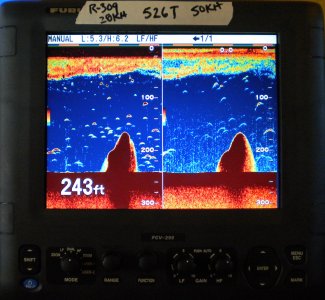A
Anonymous
Guest
I am a commercial salmon troller and we are using a Furuno FCV 1150.
I have a Airmar R99 transducer installed and also two ca50B-9B transducers installed and angled at about 18degrees, one on each side of the Vessel.
The R99 gives great definition, but a lot of the fish we catch and are looking for are at 60 to 180 feet from the surface, and the cone angle is pretty narrow at those depths.
The ca50b-9b gives us a wide view and marks bait well, but It does not give the definition to tell when Salmon are chasing the bait and have it broken and scattered.
Have you tested the new Airmar B275 LH-W ?
I also think that two of the B260s or B265s mounted in tandom should be a better choice than the ca50-9B or maybe just add another R99.
I like being able to change kHz but generally I find that my r99 works best at 52khz and 185.
I know that there are trade offs, What would you recommend to give the best definition and still have decent coverage in the 60 to 180 foot range. Thanks, Kimbo
I have a Airmar R99 transducer installed and also two ca50B-9B transducers installed and angled at about 18degrees, one on each side of the Vessel.
The R99 gives great definition, but a lot of the fish we catch and are looking for are at 60 to 180 feet from the surface, and the cone angle is pretty narrow at those depths.
The ca50b-9b gives us a wide view and marks bait well, but It does not give the definition to tell when Salmon are chasing the bait and have it broken and scattered.
Have you tested the new Airmar B275 LH-W ?
I also think that two of the B260s or B265s mounted in tandom should be a better choice than the ca50-9B or maybe just add another R99.
I like being able to change kHz but generally I find that my r99 works best at 52khz and 185.
I know that there are trade offs, What would you recommend to give the best definition and still have decent coverage in the 60 to 180 foot range. Thanks, Kimbo




